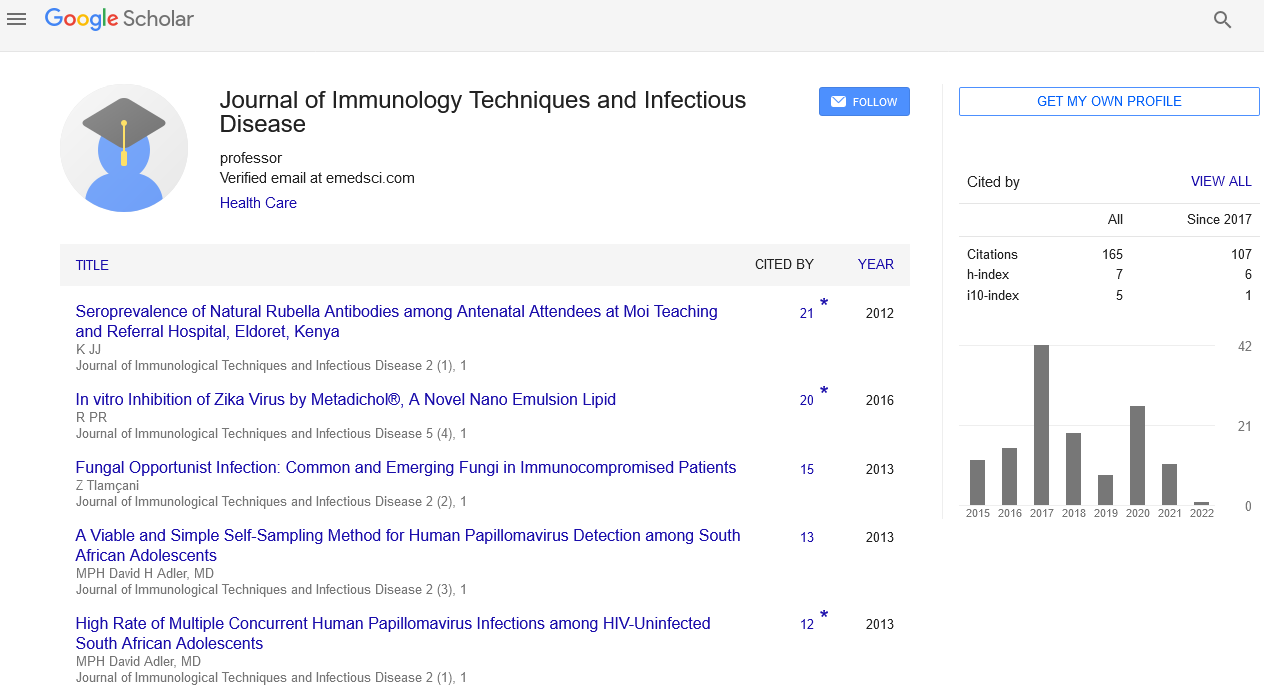Opinion Article, J Immunol Tech Infect Dis Vol: 13 Issue: 2
Advancements in Vaccine Development: Innovations and New Approaches
Huang Xiao*
1Department of Infection Diseases, Guangdong Ocean University, Zhanjiang, China
*Corresponding Author: Huang Xiao,
Department of Infection Diseases,
Guangdong Ocean University, Zhanjiang, China
E-mail: xiaohuan@gmail.com
Received date: 26 August, 2024, Manuscript No. JIDIT-24-151954;
Editor assigned date: 28 August, 2024, PreQC No. JIDIT-24-151954 (PQ);
Reviewed date: 11 September, 2024, QC No. JIDIT-24-151954;
Revised date: 18 September, 2024, Manuscript No. JIDIT-24-151954 (R);
Published date: 25 September, 2024, DOI: 10.4172/2329-9541.1000393
Citation: Ogunka-Nnoka CU, Ben-Piakor TE, Mepba HD, Ifeanacho MO (2020) Effect of Processing on Phytochemicals and Nutrient Composition of Tiger Nut (Cyperus esculentus L). J Food Nutr Disor 9:2. doi: 10.37532/jfnd.2020.9(2).271
Description
Vaccines have been a revolutionary advancement in medical science, effectively controlling and eliminating many infectious illnesses over the past century. They work by training the immune system to recognize and combat specific pathogens, making them an essential tool in global public health. However, creating a safe and effective vaccine is a complex process that requires rigorous study, extensive testing and severe regulatory oversight. Vaccine development can take years or even decades, involving multiple stages of scientific investigation, clinical trials and regulatory study before they are considered safe for public usage.
Innovations and new approaches in vaccine development
Advances in technology have led to new development methodology vaccines, accelerating the process and providing alternative methods.
mRNA vaccines: Traditional vaccines frequently use inactivated pathogens or protein subunits to stimulate an immune response. mRNA vaccines, however, use genetic instructions to develop cells to produce viral proteins, triggering an immune response. This approach, used in COVID-19 vaccines, allows for faster development and flexibility, as mRNA sequences can be adjusted to respond to emerging virus variants.
Viral vector vaccines: Viral vector vaccines use a harmless virus as a delivery system to carry genetic material from the target pathogen into cells. This method has been effective in developing vaccines for diseases such as Ebola and was also used in some COVID-19 vaccines. Viral vector vaccines are advantageous because they usually produce strong immune responses and may require fewer doses.
Recombinant protein vaccines: Recombinant protein vaccines contain purified pathogen proteins that stimulate an immune response without using live virus. They are safe and have been widely used in vaccines for diseases such as hepatitis B and HPV. Investigators are now developing recombinant protein vaccines for other diseases, such as influenza and COVID-19.
Adjuvants and vaccine delivery systems: Adjuvants are substances added to vaccines to enhance the immune response, reducing the amount of antigen needed or the number of doses required. Novel delivery systems, such as micro-needle patches, are also under development, providing pain-free and more accessible vaccine administration, particularly useful for resource-limited settings.
Phases of vaccine development
The journey of vaccine development can be divided across numerous essential phases, each with specific aims to ensure that the vaccine is both safe and effective. The development process begins with exploratory study in the lab. Scientists study the pathogen whether it is a virus, bacterium or other microorganism identifying its structure, genetic material and how it infects and affects the human body. Understanding these properties is essential for determining the best way to target the pathogen.
Once scientists have a strong understanding of the pathogen, they begin preclinical testing. At this stage, investigators test vaccine candidates on animal models to study the immune response, test for potential side effects and determine optimal dosages. Animal models are used because they offer initial safety data however; human reactions are not always completely predictable. If a vaccine candidate demonstrates potential in preclinical studies, it moves to the next phase. Investigators then submit an Investigational New Drug (IND) application to regulatory authorities, requesting authorization to proceed with human trials.
 Spanish
Spanish  Chinese
Chinese  Russian
Russian  German
German  French
French  Japanese
Japanese  Portuguese
Portuguese  Hindi
Hindi 
